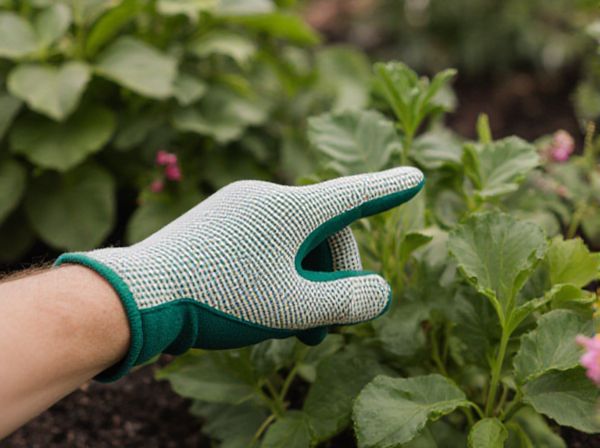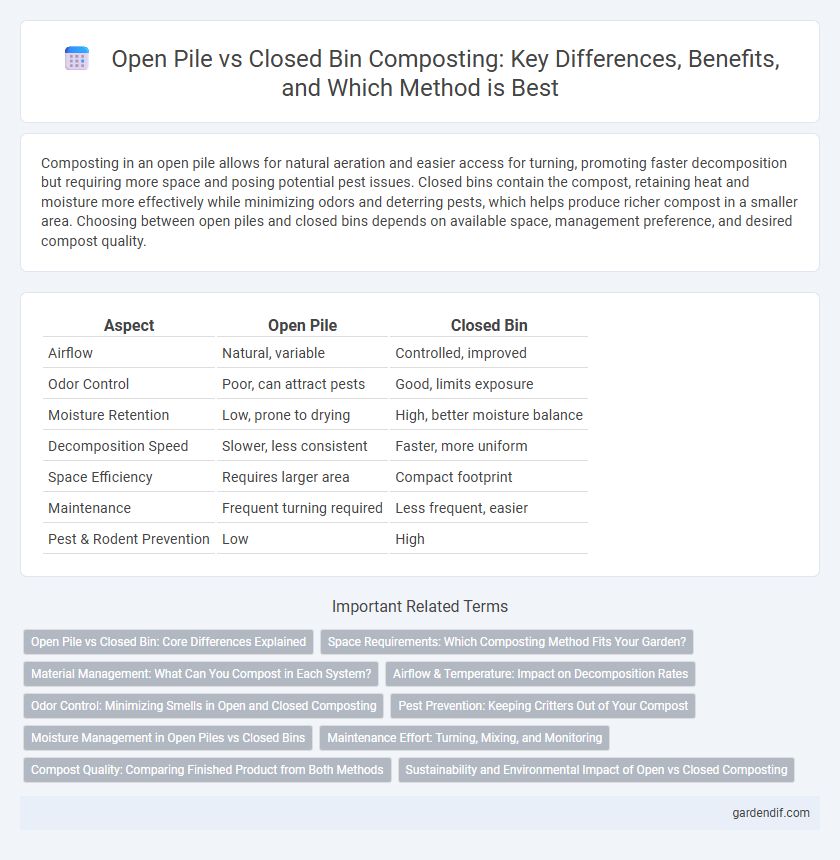
Open Pile vs Closed Bin Illustration
Composting in an open pile allows for natural aeration and easier access for turning, promoting faster decomposition but requiring more space and posing potential pest issues. Closed bins contain the compost, retaining heat and moisture more effectively while minimizing odors and deterring pests, which helps produce richer compost in a smaller area. Choosing between open piles and closed bins depends on available space, management preference, and desired compost quality.
Table of Comparison
| Aspect | Open Pile | Closed Bin |
|---|---|---|
| Airflow | Natural, variable | Controlled, improved |
| Odor Control | Poor, can attract pests | Good, limits exposure |
| Moisture Retention | Low, prone to drying | High, better moisture balance |
| Decomposition Speed | Slower, less consistent | Faster, more uniform |
| Space Efficiency | Requires larger area | Compact footprint |
| Maintenance | Frequent turning required | Less frequent, easier |
| Pest & Rodent Prevention | Low | High |
Open Pile vs Closed Bin: Core Differences Explained
Open pile composting involves layering organic waste in a heap exposed to air, promoting aerobic decomposition with natural ventilation that accelerates microbial activity. Closed bins provide a confined environment, controlling moisture and temperature more effectively, reducing odors and pests while maintaining consistent compost quality. Choosing between open piles and closed bins depends on space, compost volume, and the desired speed and hygiene of the decomposition process.
Space Requirements: Which Composting Method Fits Your Garden?
Open pile composting requires ample outdoor space, making it ideal for larger gardens where materials can be spread out and turned regularly to aerate the pile. Closed bin systems are more compact and suitable for small gardens or urban settings, containing odors and pests while accelerating decomposition through controlled conditions. Gardeners with limited space often prefer closed bins for efficient composting without compromising available yard area.
Material Management: What Can You Compost in Each System?
Open pile composting allows for the addition of larger volumes and varied organic waste such as yard trimmings, kitchen scraps, and manure, facilitating natural aeration and decomposition. Closed bin systems are ideal for managing smaller quantities of kitchen waste, coffee grounds, and shredded paper while controlling moisture levels and reducing pests. Both systems support composting of greens, browns, and biodegradable materials, but bins offer enhanced odor control and space efficiency for urban or limited areas.
Airflow & Temperature: Impact on Decomposition Rates
Open pile composting allows for greater airflow, promoting aerobic conditions that accelerate decomposition by supporting thermophilic bacteria activity. Closed bin systems restrict airflow, which may slow aerobic breakdown but help maintain higher, more consistent temperatures vital for pathogen reduction. Optimal decomposition rates rely on balancing oxygen availability and temperature control, with open piles favoring rapid breakdown and closed bins enhancing thermal efficiency.
Odor Control: Minimizing Smells in Open and Closed Composting
Open pile composting often faces challenges with odor control due to increased exposure to air and moisture, promoting anaerobic pockets that generate foul smells. Closed bin systems enhance odor management by limiting oxygen access, which reduces the production of volatile organic compounds and ammonia. Effective aeration and moisture balance in both methods are crucial for minimizing odors and accelerating the decomposition process.
Pest Prevention: Keeping Critters Out of Your Compost
Open pile composting exposes organic material to pests such as rodents, raccoons, and flies, increasing the risk of infestation and contamination. Closed bins feature secured lids and walls that create a physical barrier, effectively preventing critters from accessing the compost. Choosing a closed bin system reduces pest problems and helps maintain a cleaner, safer composting environment.
Moisture Management in Open Piles vs Closed Bins
Open pile composting often struggles with moisture management due to increased exposure to rain and evaporation, leading to inconsistent moisture levels that can slow microbial activity. Closed bins provide better control over moisture by retaining water within the system and reducing drying effects, which promotes efficient decomposition and reduces odors. Maintaining ideal moisture content, typically around 40-60%, is easier in closed bins, ensuring optimal conditions for aerobic microbes.
Maintenance Effort: Turning, Mixing, and Monitoring
Open pile composting requires frequent turning and mixing to ensure adequate aeration and temperature control, demanding consistent manual labor. Closed bin systems reduce maintenance effort by containing materials, which helps retain moisture and heat while minimizing the need for regular turning. Monitoring in closed bins is simplified due to controlled conditions, whereas open piles require ongoing observation to prevent odor and pest issues.
Compost Quality: Comparing Finished Product from Both Methods
Open pile composting often results in a less uniform finished product with variable moisture and temperature levels, leading to inconsistent nutrient content and decomposition rates. Closed bin systems provide better control over aeration, moisture, and temperature, producing higher-quality compost with more stable nutrient profiles and fewer contaminants. The enclosed environment in closed bins fosters faster microbial activity, enhancing the breakdown of organic matter into a nutrient-rich, homogenous soil amendment.
Sustainability and Environmental Impact of Open vs Closed Composting
Open pile composting promotes natural aeration and biodegradation but can lead to higher greenhouse gas emissions and nutrient runoff, impacting soil and water quality. Closed bin composting offers controlled conditions that reduce methane and odor emissions while enhancing nutrient retention and minimizing leachate, thus improving overall environmental sustainability. Choosing closed bin systems aligns with sustainable waste management by mitigating pollution and accelerating compost maturity.
Open Pile vs Closed Bin Infographic

 gardendif.com
gardendif.com